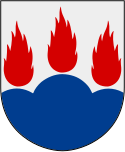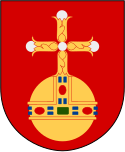Svealand
| Historyczny kraj | |
 | |
| Państwo | |
|---|---|
| Populacja • liczba ludności | 4 044 083 |
Położenie na mapie Szwecji | |
| Portal | |
Svealand lub Szwecja Właściwa to historyczny kraj w Szwecji. Kraj ten jest usytuowany w centralnej części państwa. Od północy graniczy on z Norrlandią, zaś od południa z Götaland. Svealand była w dawnych czasach oddzielona od Götaland puszczami Tiveden, Tylöskog i Kolmården. Mieszkańcy tego rejonu byli nazywani Svearami.
Na Svealand składają się na wschodzie Mälardalen (ze stolicą Szwecji Sztokholmem), na północnym wschodzie Roslagen, w centrum obszar górniczy Bergslagen oraz na zachodzie Dalarna.
Nazwa Szwecji w języku szwedzkim, Svea rike (we współczesnej ortografii Sverige, w innym zapisie Sweoðeod, lub Sweorice, w języku staronordyckim/języku islandzkim Svíþjóð), czyli "Królestwo Szwedów", pierwotnie odnosiła się wyłącznie do Svealand. W miarę jak zasięg władzy królów Szwecji rósł, nazwa Svealand zaczęła być używana w celu odróżnienia starych ziem od nowych.
Historyczne krainy
W skład Svealand wchodzi sześć krain:
Historia
Svealand to obszar, który pierwotnie oznaczał Szwecję. Od nazwy tego historycznego kraju pochodzi obecna nazwa państwa. Świadczą o tym porównania lingwistyczne oraz wczesnośredniowieczne źródła pisane, np. sagi. W staronordyjskim i staroangielskim Svealand oraz Szwecja były synonimami. Słowa te zaś określano jako państwo różne od Götaland/Gautland/Geatland. Na przykład w Sögubrot af Nokkrum [1] wspomina się, że Kolmården służy za granicę między Svealand a Östergötland (...Kolmerkr, er skilr Svíþjóð ok Eystra-Gautland...), zaś w Sadze Hervarara [2], król Ingold I udaje się do Szwecji przez Östergötland: Ingi konungr fór með hirð sína ok sveit nokkura ok hafði lítinn her. Hann reið austr um Smáland ok í eystra Gautland ok svá í Svíþjóð. Również późniejsze zapisy wskazują na utożsamianie nazwy Szwecja ze Svealand. Bo Jonsson Grip prawdopodobnie najlepiej znał geografię starego królestwa Szwecji, gdyż w jego posiadaniu znajdowała się ponad połowa jego terytorium. W roku 1384 zapisał on w swoim testamencie, że w jego czasach królestwo składało się ze Swerige (Szwecji, tzn. Svealand), Österland (tzn. Finlandii) oraz Göthaland (tzn. Götaland).
Z czasem nazwy Sverige i Svealand przestały oznaczać to samo, gdy na przykład w wyniku wyprawy krzyżowej na wschód rozpoczętej przez królów Svealand w XII wieku zostały zdobyte tereny Österland (dawniejsza nazwa Finlandii).
Od pewnego momentu na początku XIX wieku kraina Värmland stała się własnością Sądu Apelacyjnego Svealand. W związku z tym, chociaż Värmland historycznie należała do Götaland, to zwyczajowo od dawna jest uważana za część Svealand.
Zobacz też
Linki zewnętrzne
Media użyte na tej stronie
(c) Lokal_Profil, CC BY-SA 2.5
This coat of arms was drawn based on its blazon which – being a written description – is free from copyright. Any illustration conforming with the blazon of the arms is considered to be heraldically correct. Thus several different artistic interpretations of the same coat of arms can exist. The design officially used by the armiger is likely protected by copyright, in which case it cannot be used here.
Individual representations of a coat of arms, drawn from a blazon, may have a copyright belonging to the artist, but are not necessarily derivative works.
(c) Lokal_Profil, CC BY-SA 2.5
This coat of arms was drawn based on its blazon which – being a written description – is free from copyright. Any illustration conforming with the blazon of the arms is considered to be heraldically correct. Thus several different artistic interpretations of the same coat of arms can exist. The design officially used by the armiger is likely protected by copyright, in which case it cannot be used here.
Individual representations of a coat of arms, drawn from a blazon, may have a copyright belonging to the artist, but are not necessarily derivative works.
(c) Lokal_Profil, CC BY-SA 2.5
This coat of arms was drawn based on its blazon which – being a written description – is free from copyright. Any illustration conforming with the blazon of the arms is considered to be heraldically correct. Thus several different artistic interpretations of the same coat of arms can exist. The design officially used by the armiger is likely protected by copyright, in which case it cannot be used here.
Individual representations of a coat of arms, drawn from a blazon, may have a copyright belonging to the artist, but are not necessarily derivative works.
Autor: Lapplänning, Licencja: CC BY-SA 2.5
Map of Sweden with the region Svealand marked.
Great coat of arms of Sweden
Autor: Udo Schröter, Licencja: CC BY-SA 3.0
Sparren, Norrtälje kommun, vy från öst
(c) Lokal_Profil, CC BY-SA 2.5
This coat of arms was drawn based on its blazon which – being a written description – is free from copyright. Any illustration conforming with the blazon of the arms is considered to be heraldically correct. Thus several different artistic interpretations of the same coat of arms can exist. The design officially used by the armiger is likely protected by copyright, in which case it cannot be used here.
Individual representations of a coat of arms, drawn from a blazon, may have a copyright belonging to the artist, but are not necessarily derivative works.
(c) Lokal_Profil, CC BY-SA 2.5
This coat of arms was drawn based on its blazon which – being a written description – is free from copyright. Any illustration conforming with the blazon of the arms is considered to be heraldically correct. Thus several different artistic interpretations of the same coat of arms can exist. The design officially used by the armiger is likely protected by copyright, in which case it cannot be used here.
Individual representations of a coat of arms, drawn from a blazon, may have a copyright belonging to the artist, but are not necessarily derivative works.
(c) Lokal_Profil, CC BY-SA 2.5
This coat of arms was drawn based on its blazon which – being a written description – is free from copyright. Any illustration conforming with the blazon of the arms is considered to be heraldically correct. Thus several different artistic interpretations of the same coat of arms can exist. The design officially used by the armiger is likely protected by copyright, in which case it cannot be used here.
Individual representations of a coat of arms, drawn from a blazon, may have a copyright belonging to the artist, but are not necessarily derivative works.














